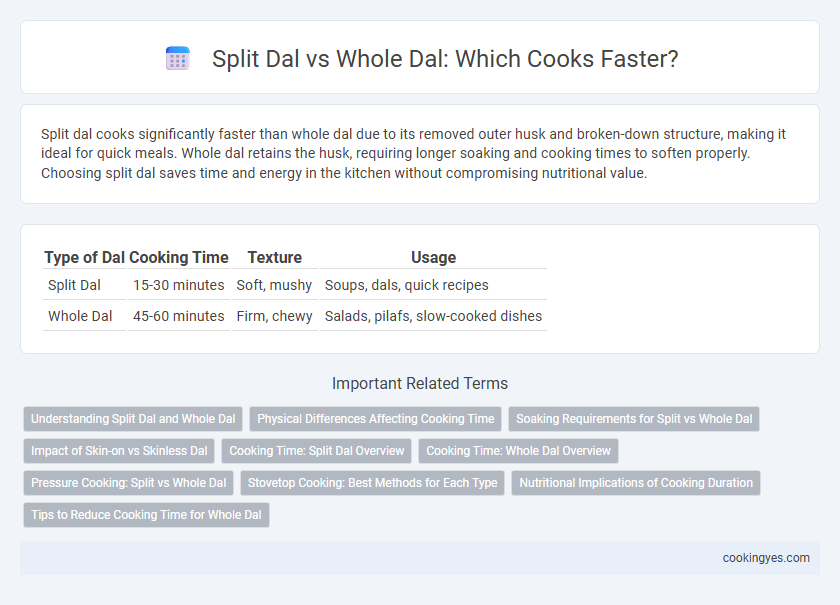Split dal cooks significantly faster than whole dal due to its removed outer husk and broken-down structure, making it ideal for quick meals. Whole dal retains the husk, requiring longer soaking and cooking times to soften properly. Choosing split dal saves time and energy in the kitchen without compromising nutritional value.
Table of Comparison
| Type of Dal | Cooking Time | Texture | Usage |
|---|---|---|---|
| Split Dal | 15-30 minutes | Soft, mushy | Soups, dals, quick recipes |
| Whole Dal | 45-60 minutes | Firm, chewy | Salads, pilafs, slow-cooked dishes |
Understanding Split Dal and Whole Dal
Split dal cooks significantly faster than whole dal due to the removal of the outer husk and split in half, which allows water and heat to penetrate more quickly. Whole dal retains its outer layer, requiring longer soaking and cooking times to soften completely. Understanding the difference in cooking times between split and whole dal is crucial for meal preparation and achieving the desired texture in dishes.
Physical Differences Affecting Cooking Time
Split dal cooks faster than whole dal due to the removal of the outer husk and splitting of the lentil, which reduces its size and allows heat and water to penetrate more quickly. Whole dal retains the intact bran layer and husk, creating a barrier that extends cooking time by slowing water absorption and heat transfer. These physical differences directly impact the soaking and boiling durations, making split dal preferred for quicker meal preparation.
Soaking Requirements for Split vs Whole Dal
Split dal typically requires less or no soaking time compared to whole dal, significantly reducing overall cooking duration. Whole dal benefits from soaking for at least 6-8 hours to soften the grains and ensure even cooking, preventing hardness and longer cooking times. Soaking split dal for 30 minutes to an hour can enhance texture but is not mandatory, while whole dal's soaking is essential for optimal tenderness and digestibility.
Impact of Skin-on vs Skinless Dal
Split dal cooks faster than whole dal because removing the skin reduces cooking time by allowing heat to penetrate more quickly, which softens the lentils faster. Skin-on dal retains its outer layer, requiring longer soaking and cooking times due to the tougher cellulose barrier. This difference significantly impacts meal preparation time, especially in recipes needing quick cooking or consistent texture.
Cooking Time: Split Dal Overview
Split dal cooks significantly faster than whole dal due to the removal of the outer husk, reducing overall cooking time by up to 50%. It absorbs water more quickly and softens easily, making it ideal for quick meals and recipes requiring shorter preparation. Whole dal requires prolonged boiling and soaking, often doubling the cooking time compared to split dal varieties.
Cooking Time: Whole Dal Overview
Whole dal requires significantly longer cooking time compared to split dal due to the intact husk and outer layers that protect the grain. Generally, whole dal takes about 30 to 45 minutes to cook, whereas split dal cooks within 15 to 20 minutes. Soaking whole dal before cooking can reduce this time by softening the grains and improving cooking efficiency.
Pressure Cooking: Split vs Whole Dal
Split dal cooks significantly faster than whole dal in a pressure cooker due to the removal of the outer husk, which allows water to penetrate quickly and softens the lentils faster. Whole dal requires longer cooking times under pressure to fully break down the intact outer layer, ensuring proper texture and digestibility. For pressure cooking efficiency, split dal is ideal for quick meals, while whole dal is preferred when a heartier texture is desired despite increased cooking time.
Stovetop Cooking: Best Methods for Each Type
Split dal cooks significantly faster on the stovetop, typically requiring 20 to 30 minutes of simmering due to its reduced size and removal of the outer husk. Whole dal needs longer cooking times, often 45 to 60 minutes, as the intact seed coat slows water absorption and softening. For optimal stovetop results, simmer split dal gently in a covered pot to prevent drying, while whole dal benefits from pre-soaking and consistent moderate heat to ensure even cooking.
Nutritional Implications of Cooking Duration
Split dal cooks faster than whole dal due to its smaller size and removed husk, reducing cooking time significantly. This shorter cooking duration helps preserve heat-sensitive nutrients such as certain B vitamins and antioxidants that can degrade with prolonged cooking. Conversely, whole dal retains more fiber and slows nutrient release, promoting better digestion but requires longer cooking, which may slightly reduce some heat-sensitive nutrients.
Tips to Reduce Cooking Time for Whole Dal
Split dal cooks significantly faster than whole dal due to its reduced size and absence of the outer husk. To reduce cooking time for whole dal, soak it in warm water for at least 4-6 hours or overnight to soften the grains. Using a pressure cooker and adding a pinch of baking soda can further accelerate the cooking process by breaking down the tough outer layer.
Split Dal vs Whole Dal for Cooking Time Infographic

 cookingyes.com
cookingyes.com